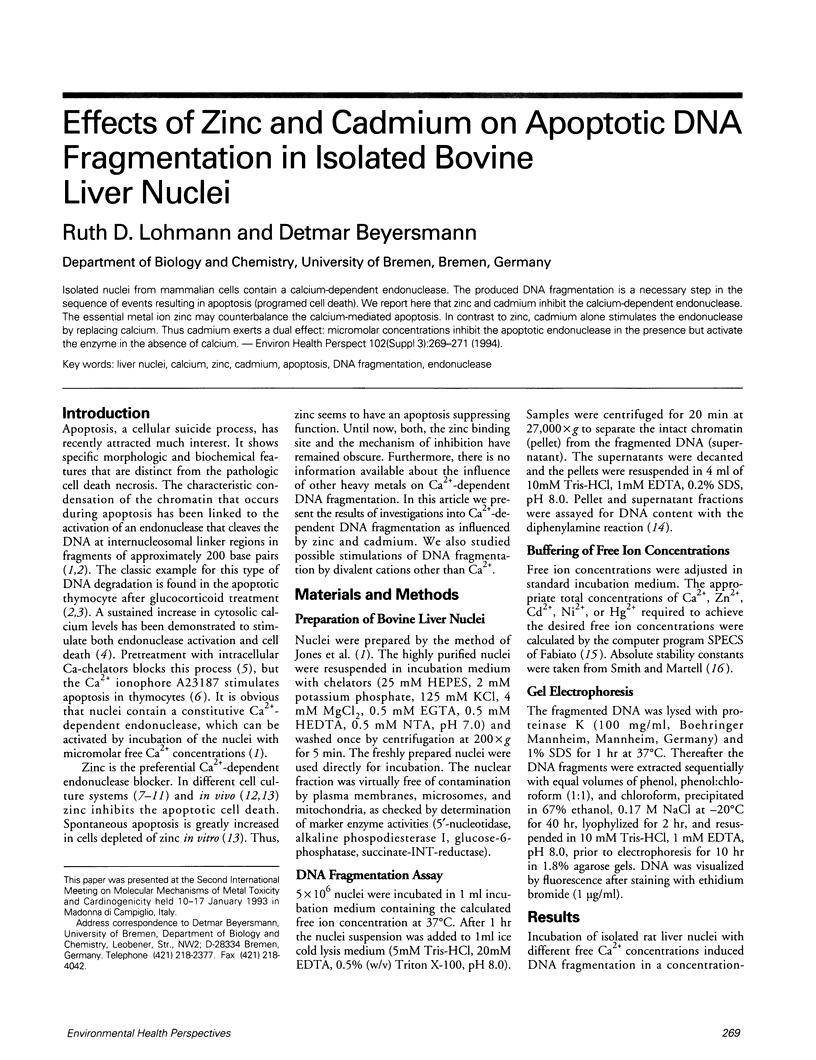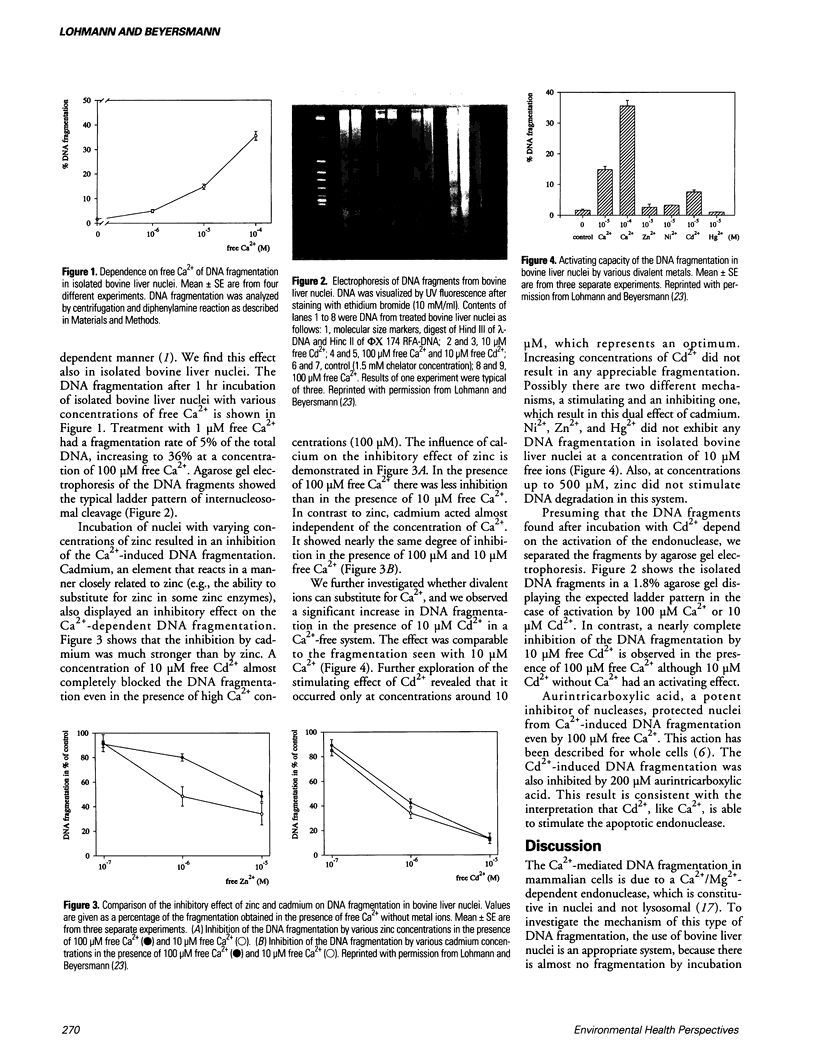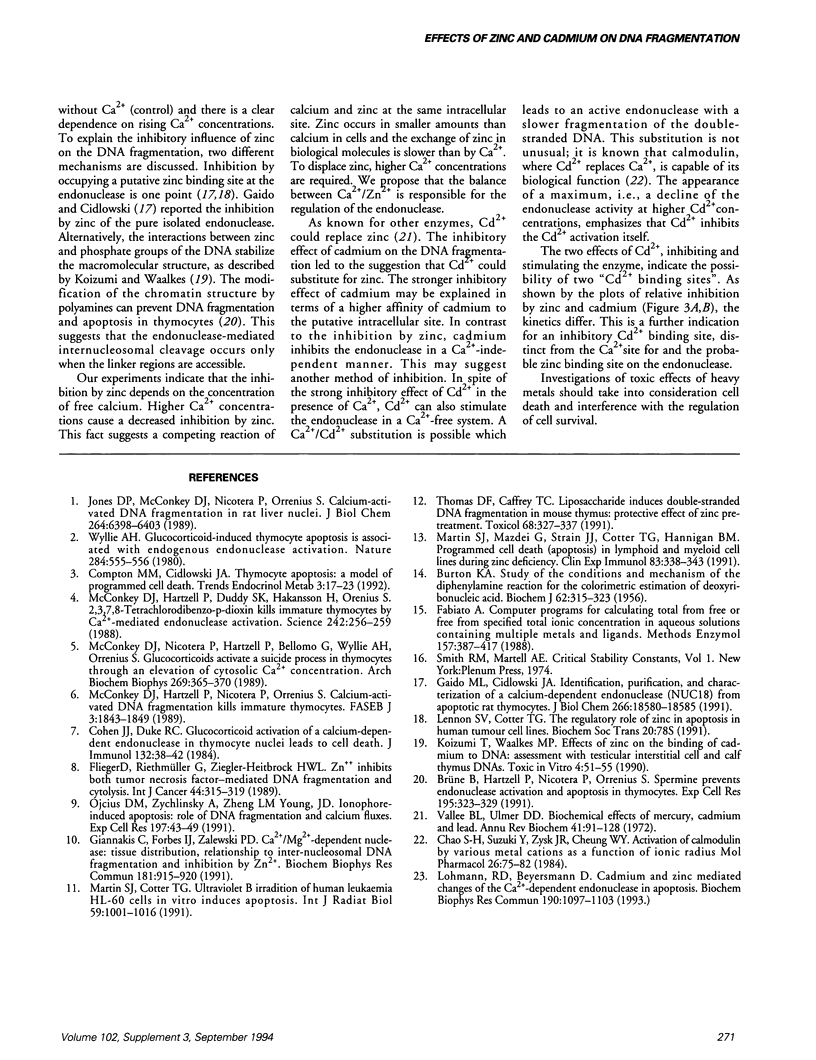Abstract
Isolated nuclei from mammalian cells contain a calcium-dependent endonuclease. The produced DNA fragmentation is a necessary step in the sequence of events resulting in apoptosis (programmed cell death). We report here that zinc and cadmium inhibit the calcium-dependent endonuclease. The essential metal ion zinc may counterbalance the calcium-mediated apoptosis. In contrast to zinc, cadmium alone stimulates the endonuclease by replacing calcium. Thus cadmium exerts a dual effect: micromolar concentrations inhibit the apoptotic endonuclease in the presence but activate the enzyme in the absence of calcium.
Full text
PDF


Images in this article
Selected References
These references are in PubMed. This may not be the complete list of references from this article.
- BURTON K. A study of the conditions and mechanism of the diphenylamine reaction for the colorimetric estimation of deoxyribonucleic acid. Biochem J. 1956 Feb;62(2):315–323. doi: 10.1042/bj0620315. [DOI] [PMC free article] [PubMed] [Google Scholar]
- Brüne B., Hartzell P., Nicotera P., Orrenius S. Spermine prevents endonuclease activation and apoptosis in thymocytes. Exp Cell Res. 1991 Aug;195(2):323–329. doi: 10.1016/0014-4827(91)90380-d. [DOI] [PubMed] [Google Scholar]
- Chao S. H., Suzuki Y., Zysk J. R., Cheung W. Y. Activation of calmodulin by various metal cations as a function of ionic radius. Mol Pharmacol. 1984 Jul;26(1):75–82. [PubMed] [Google Scholar]
- Cohen J. J., Duke R. C. Glucocorticoid activation of a calcium-dependent endonuclease in thymocyte nuclei leads to cell death. J Immunol. 1984 Jan;132(1):38–42. [PubMed] [Google Scholar]
- Fabiato A. Computer programs for calculating total from specified free or free from specified total ionic concentrations in aqueous solutions containing multiple metals and ligands. Methods Enzymol. 1988;157:378–417. doi: 10.1016/0076-6879(88)57093-3. [DOI] [PubMed] [Google Scholar]
- Flieger D., Riethmüller G., Ziegler-Heitbrock H. W. Zn++ inhibits both tumor necrosis factor-mediated DNA fragmentation and cytolysis. Int J Cancer. 1989 Aug 15;44(2):315–319. doi: 10.1002/ijc.2910440221. [DOI] [PubMed] [Google Scholar]
- Gaido M. L., Cidlowski J. A. Identification, purification, and characterization of a calcium-dependent endonuclease (NUC18) from apoptotic rat thymocytes. NUC18 is not histone H2B. J Biol Chem. 1991 Oct 5;266(28):18580–18585. [PubMed] [Google Scholar]
- Giannakis C., Forbes I. J., Zalewski P. D. Ca2+/Mg(2+)-dependent nuclease: tissue distribution, relationship to inter-nucleosomal DNA fragmentation and inhibition by Zn2+. Biochem Biophys Res Commun. 1991 Dec 16;181(2):915–920. doi: 10.1016/0006-291x(91)91278-k. [DOI] [PubMed] [Google Scholar]
- Jones D. P., McConkey D. J., Nicotera P., Orrenius S. Calcium-activated DNA fragmentation in rat liver nuclei. J Biol Chem. 1989 Apr 15;264(11):6398–6403. [PubMed] [Google Scholar]
- Lennon S. V., Cotter T. G. The regulatory role of zinc in apoptosis in human tumour cell lines. Biochem Soc Trans. 1992 Feb;20(1):78S–78S. doi: 10.1042/bst020078s. [DOI] [PubMed] [Google Scholar]
- Lohmann R. D., Beyersmann D. Cadmium and zinc mediated changes of the Ca(2+)-dependent endonuclease in apoptosis. Biochem Biophys Res Commun. 1993 Feb 15;190(3):1097–1103. doi: 10.1006/bbrc.1993.1162. [DOI] [PubMed] [Google Scholar]
- Martin S. J., Cotter T. G. Ultraviolet B irradiation of human leukaemia HL-60 cells in vitro induces apoptosis. Int J Radiat Biol. 1991 Apr;59(4):1001–1016. doi: 10.1080/09553009114550891. [DOI] [PubMed] [Google Scholar]
- Martin S. J., Mazdai G., Strain J. J., Cotter T. G., Hannigan B. M. Programmed cell death (apoptosis) in lymphoid and myeloid cell lines during zinc deficiency. Clin Exp Immunol. 1991 Feb;83(2):338–343. doi: 10.1111/j.1365-2249.1991.tb05639.x. [DOI] [PMC free article] [PubMed] [Google Scholar]
- McConkey D. J., Hartzell P., Duddy S. K., Håkansson H., Orrenius S. 2,3,7,8-Tetrachlorodibenzo-p-dioxin kills immature thymocytes by Ca2+-mediated endonuclease activation. Science. 1988 Oct 14;242(4876):256–259. doi: 10.1126/science.3262923. [DOI] [PubMed] [Google Scholar]
- McConkey D. J., Hartzell P., Nicotera P., Orrenius S. Calcium-activated DNA fragmentation kills immature thymocytes. FASEB J. 1989 May;3(7):1843–1849. doi: 10.1096/fasebj.3.7.2497041. [DOI] [PubMed] [Google Scholar]
- McConkey D. J., Nicotera P., Hartzell P., Bellomo G., Wyllie A. H., Orrenius S. Glucocorticoids activate a suicide process in thymocytes through an elevation of cytosolic Ca2+ concentration. Arch Biochem Biophys. 1989 Feb 15;269(1):365–370. doi: 10.1016/0003-9861(89)90119-7. [DOI] [PubMed] [Google Scholar]
- Ojcius D. M., Zychlinsky A., Zheng L. M., Young J. D. Ionophore-induced apoptosis: role of DNA fragmentation and calcium fluxes. Exp Cell Res. 1991 Nov;197(1):43–49. doi: 10.1016/0014-4827(91)90477-c. [DOI] [PubMed] [Google Scholar]
- Thomas D. J., Caffrey T. C. Lipopolysaccharide induces double-stranded DNA fragmentation in mouse thymus: protective effect of zinc pretreatment. Toxicology. 1991;68(3):327–337. doi: 10.1016/0300-483x(91)90078-f. [DOI] [PubMed] [Google Scholar]
- Vallee B. L., Ulmer D. D. Biochemical effects of mercury, cadmium, and lead. Annu Rev Biochem. 1972;41(10):91–128. doi: 10.1146/annurev.bi.41.070172.000515. [DOI] [PubMed] [Google Scholar]
- Wyllie A. H. Glucocorticoid-induced thymocyte apoptosis is associated with endogenous endonuclease activation. Nature. 1980 Apr 10;284(5756):555–556. doi: 10.1038/284555a0. [DOI] [PubMed] [Google Scholar]



